- Support portal
- Evaluation Kits and partner products
u-blox Support
- Product documentation
Documentation
- Investor relations
Investor relations
Technology
|
08 Jan 2024
Matter: Smart home connectivity unleashed
Leveraging the open-source connectivity standard Matter, smart home solutions integrate seamlessly into easy-to-use, interoperable, reliable, and secure, domestic IoT networks.
Matter is set to unleash a new wave of smart home technology adoption. Designed with simplicity, reliability, interoperability, and security at its forefront, and driven by the biggest names in the business, it has emerged as the leading contender for a new universal connectivity standard for smart home products.
But what is Matter? What makes Matter different from the standards that came before it? How does Matter work? And what’s the best way to start developing Matter smart home products?
Here, we peel back the layers on what could become the new de facto industry standard in smart home connectivity. Find out how to reap the considerable rewards that await those with the right ideas, hardware, know-how, and partners to bring Matter-compliant solutions to the market.
What is Matter?
Matter is a unified IP-based protocol designed to connect smart devices across brands and smart home ecosystems. Driven by the Connectivity Standards Alliance (CSA), it was developed to overcome the key barriers holding back adoption of smart home technology, with a focus on simplicity, interoperability, reliability, and security.
Backed by over 340 members including industry-leading companies, the Matter standard places stringent demands on device development and certification to streamline the user experience of other stakeholder groups.
"Matter is a seal of approval that devices will work seamlessly together – today and tomorrow." - CSA
Matter leverages established wired and wireless communication technologies including Wi-Fi, Thread, and Ethernet for data communication and Bluetooth LE for device provisioning. First released in October 2022, over 1,200 Matter-certified products were available on the market by the end of 2023.
Why does it matter?
When it comes to industry support, Matter is currently in a league of its own. The standard is backed by global brands including Apple, Google, Amazon, Samsung, Ikea, Panasonic, Philips, and Wiz, and chipmakers including NXP, Infinion, Nordic, Espressif, and Silicon Labs.
Source: Matter Retail Education Presentation
This allows Matter to set itself apart through a cross-industry consensus-driven approach that enforces interoperability, ease of use, and security of smart home products by imposing a demanding certification scheme and adherence to a comprehensive specification.
The technologies behind the Matter connectivity standard
Matter builds on communication technologies that are already well established in connected buildings.
- Wi-Fi, already heavily relied on in today’s connected buildings for applications such as smart lighting and connected thermostats, offers the bandwidth required to stream real-time audio and high-resolution video.
- Thread, a relative newcomer, was selected as the low-power wireless technology connecting smart home devices. Based on IEEE 802.15.4, the Thread protocol uses mesh networking to reliably and quickly relay signals across buildings and offers years of battery life.
- Ethernet offers a wired complement for high-bandwidth and real-time applications such as video and audio streaming.
- Bluetooth plays a secondary role, enabling device commissioning using commercial devices such as smart phones or tablets.
The anatomy of a Matter network
Matter smart home networks use various network components to connect individual devices, which can take on various roles, illustrated in the image below:
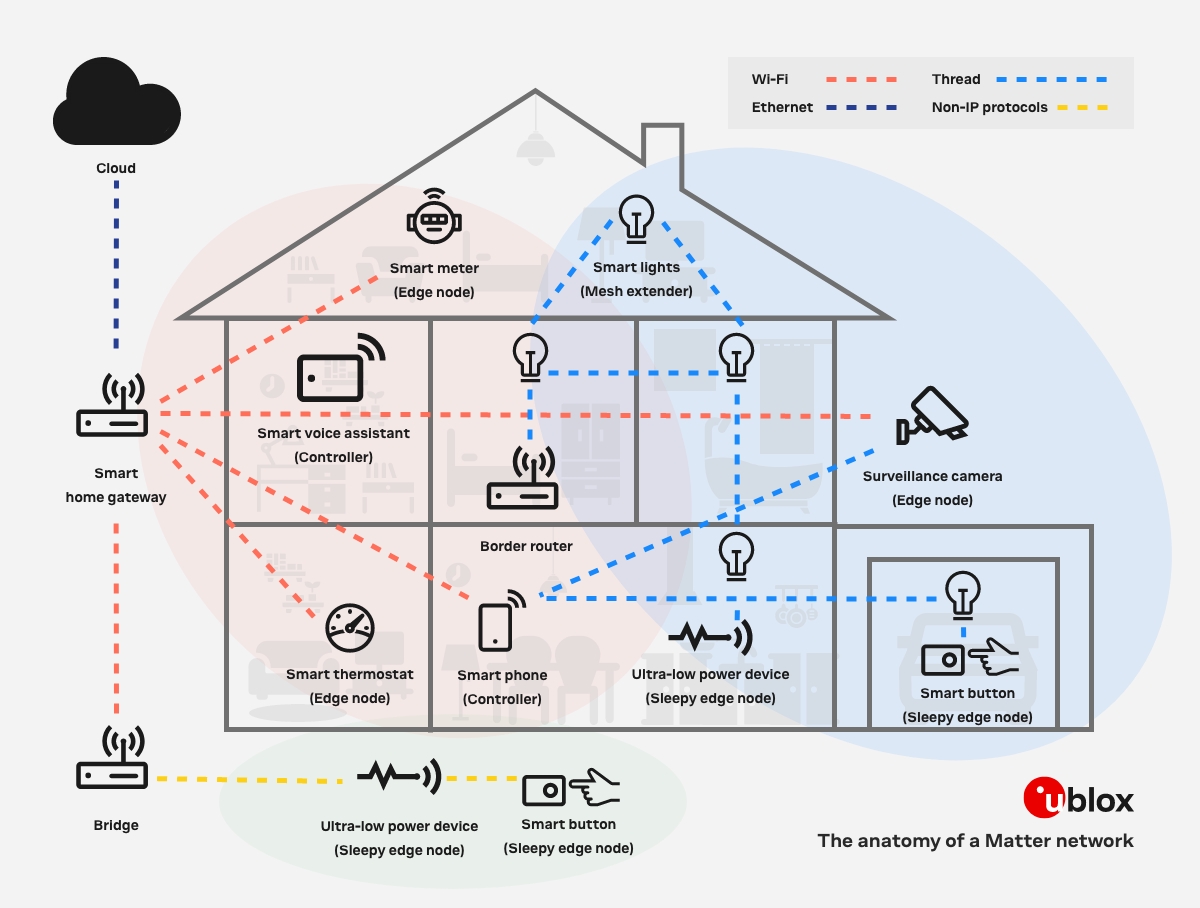
The most visible components of Matter networks are individual smart home products – sensors, actuators, switches, or other end devices. Some of these – typically more powerful, always-on devices – can act as controllers, capable of controlling other Matter devices in the network. Others can serve as bridges, allowing products that use other protocols (for example Zigbee or Z-Wave) to connect to and participate in Matter networks.
In addition, Matter networks use Thread border routers to allow Thread devices to connect with other IP-based devices (Wi-Fi, Ethernet). They can integrate Thread mesh extenders to enhance the range of the Thread network, as well as a home gateway to connect the Matter network with the internet. Underlying it all is a smart home platform that connects and controllers the Matter devices deployed in the network.
Strengths and weaknesses of the Matter standard
The Matter standard was specifically designed to address pain points perceived by various relevant stakeholder groups. It’s no wonder, therefore, that comes with a long list of benefits.
Matter finally offers customers smart home devices that are easy to set up, operate securely and reliably, and connect seamlessly to existing smart home platforms and devices.
Simplified adoption by end-users translates to reduced returns, benefitting retailers, who also stand to gain from reduced training requirements and overall streamlined operations, from stock keeping, supply chain, and point of sale.
Finally, the Matter standard benefits the overall smart home technology ecosystem by boosting adoption, growing the market, increase security, and unleashing economies of scale.
The demanding device and security specifications that enable these benefits are, however, behind the Matter standard’s most obvious weakness: The development and certification of Matter-compliant devices is considerably more complex, costly, and protracted than that of standard devices.
While, today, everything points to the Matter standard prevailing as the predominant smart home connectivity standard, its success cannot be guaranteed. As a result, device manufacturers eager to keep ahead of competitors must wager high upfront costs in hopes of later rewards.
Considering the large potential sales volume of safe, reliable, and easy-to-use smart home solutions, the returns can be substantial.
Matter smart home use cases
As the Matter standard matures, it will support a growing range of smart home devices. The follow presents four common Matter smart home use cases.
 Matter compliant smart lighting solutions connect natively with smart home platforms and apps from which they can be switched on and off, dimmed, and color-controlled. Smart lighting solutions typically connect to the network using Wi-Fi or Thread. |
 Matter-enabled battery-powered smart door locks and access control solutions connect seamlessly to existing smart home platform via a Thread border router. |
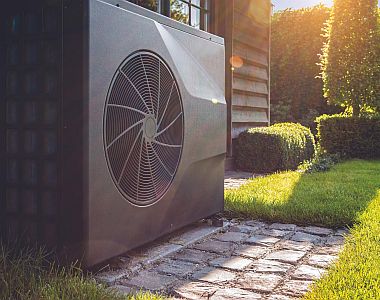 Matter allows users to set their smart thermostats to control their indoor climate using their smart home platform and apps. |
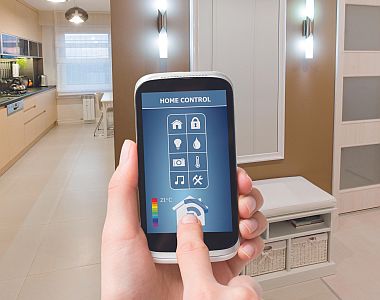 Matter networks use a Matter controller to connect and control other devices in the network. These devices need to be connected to the network via Wi-Fi or Ethernet and must always be powered on. Some can include a Thread border router, which is required to wirelessly connect Thread devices to the network. |
A growing range of use cases
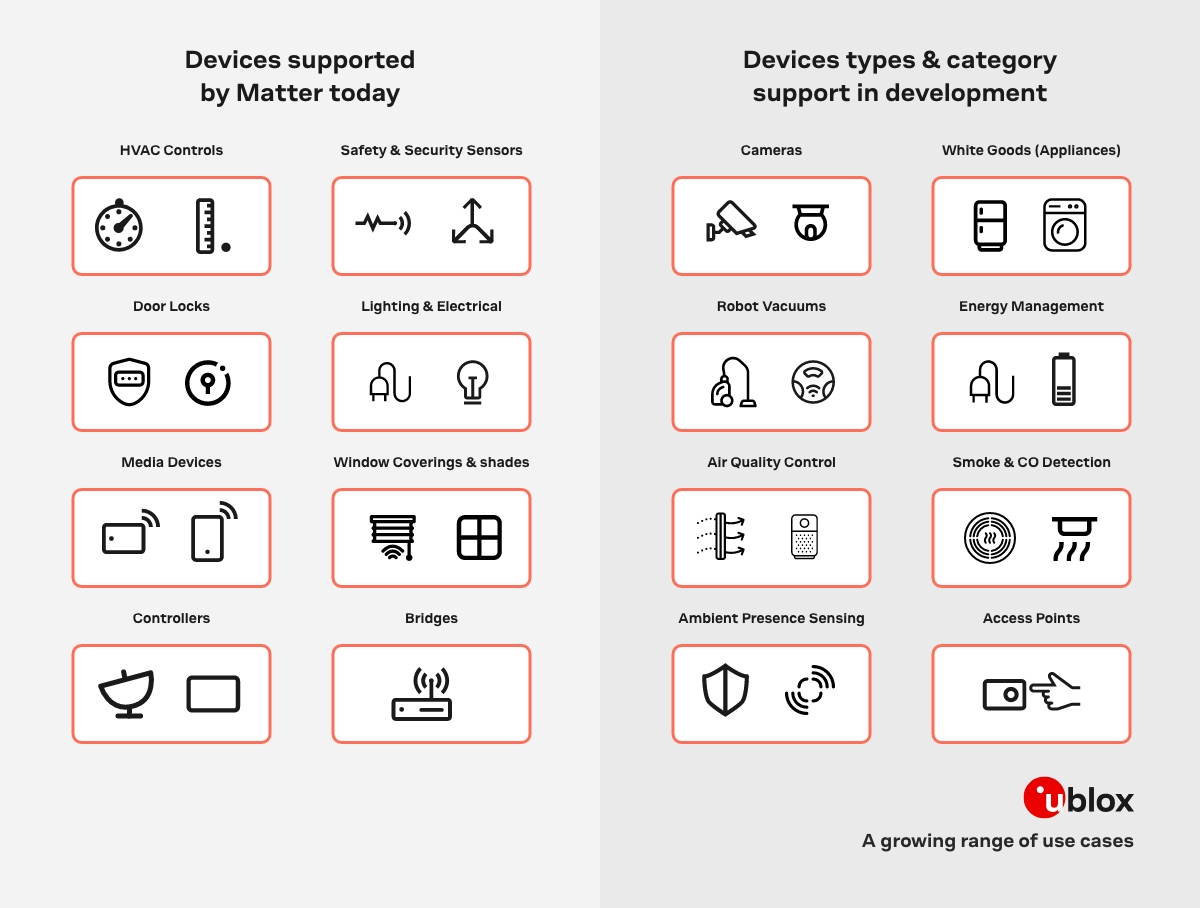
Caption: Devices supported since Matter V1.0 released in October 2022 (left) and new additions to the Matter device ecosystem introduced with the release of Matter V1.2, released in October 2023 (adapted from Matter Retail Education Presentation).
Start your Matter product development journey with u-blox
At u-blox, we offer a comprehensive range of Matter-compliant Wi-Fi, Bluetooth, and multiradio modules tailored to smart home and smart building applications. Developed with our key chipset partners NXP, Nordic Semiconductor, Infinion, Espressif, and Realtek, our hardware addresses all device types specified in the Matter standard, including Matter Wi-Fi and Thread edge nodes as well as Matter controllers and Thread border routers.
Our module-based form-factor approach mitigates risks and allows for easy migration and product upgrades. Pre-certified and professionally qualified, our broad module portfolio offers maximum design flexibility with a multitude of antenna configurations, LTE signal filtering, dual and tri radio.
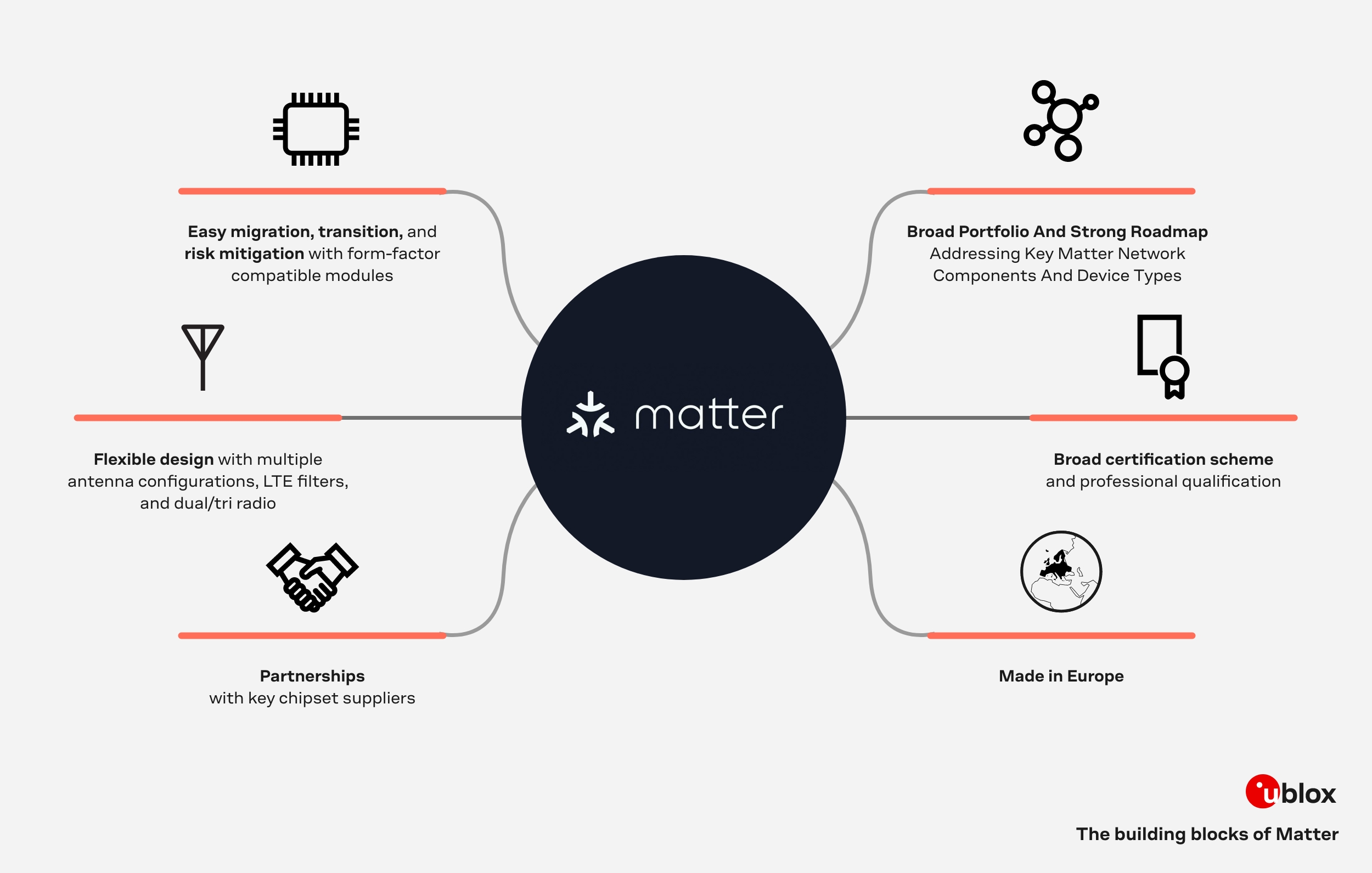
u-blox solutions for Matter smart home devices
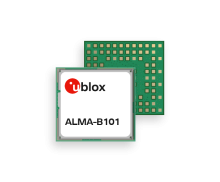
ALMA-B1 series (open CPU)
Stand-alone Bluetooth 5.4 Low Energy modules
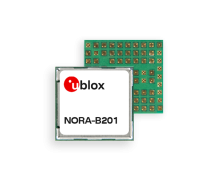
NORA-B20 series (open CPU)
Stand-alone Bluetooth 5.4 Low Energy modules
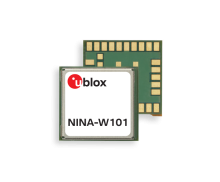
NINA-W10 series (open CPU)
Stand-alone multiradio modules
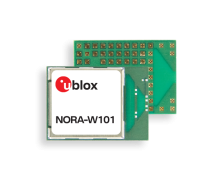
NORA-W10 series
Stand-alone multiradio modules
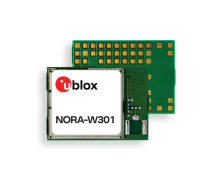
NORA-W30 series
Stand-alone dual-band Wi-Fi modules with Bluetooth Low Energy
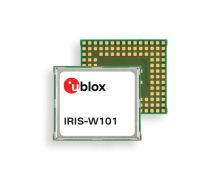
IRIS-W10 series
Stand-alone Wi-Fi 6 multiradio modules
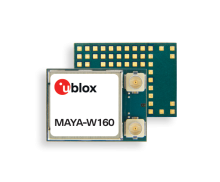
MAYA-W1 series
Host-based multiradio modules with Wi-Fi 4 and Bluetooth 5.2

MAYA-W2 series
Host-based Wi-Fi 6, Bluetooth 5.3, and 802.15.4 modules for the IoT

MAYA-W3 series
Host-based Wi-Fi 6/6E and Bluetooth 5.4 modules for the IoT

NINA-B30 series (open CPU)
Stand-alone Bluetooth 5 low energy modules

NORA-B1 series (open CPU)
Stand-alone Bluetooth 5.2 low energy modules

BMD-34 series (open CPU)
Stand-alone Bluetooth 5.0 low energy modules

BMD-380 (open CPU)
Stand-alone Bluetooth 5.1 low energy modules
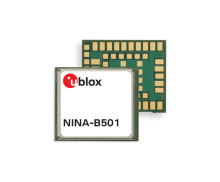
NINA-B50 series (open CPU)
Stand-alone Bluetooth 5.3 low energy modules
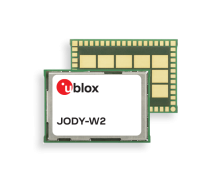
JODY-W2 series
Host-based multiradio modules with Wi-Fi and Bluetooth
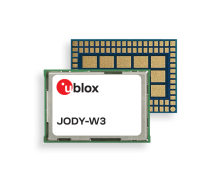
JODY-W3 series
Host-based automotive modules with Wi-Fi 6 and Bluetooth 5.3